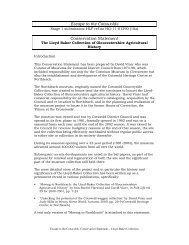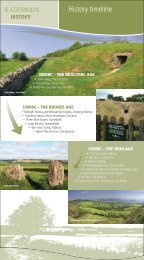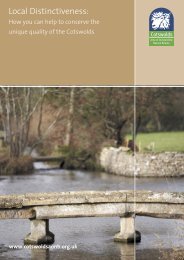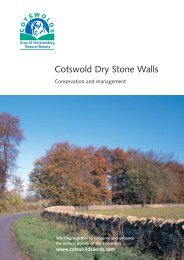AONB LCAR S1 P1-10 FINAL - the Cotswolds Area of Outstanding ...
AONB LCAR S1 P1-10 FINAL - the Cotswolds Area of Outstanding ...
AONB LCAR S1 P1-10 FINAL - the Cotswolds Area of Outstanding ...
Create successful ePaper yourself
Turn your PDF publications into a flip-book with our unique Google optimized e-Paper software.
2 Evolution <strong>of</strong> <strong>the</strong> Landscape<br />
formerly much in demand for building stone. Indeed most<br />
<strong>of</strong> <strong>the</strong> scarp quarries exploited <strong>the</strong> Freestones, including<br />
<strong>the</strong> large quarry at Leckhampton Hill, which supplied<br />
much <strong>of</strong> <strong>the</strong> stone used to build Cheltenham including <strong>the</strong><br />
Royal Crescent and <strong>the</strong> Montpellier Rotunda. Perhaps <strong>the</strong><br />
most well known feature formed from Inferior Oolite is <strong>the</strong><br />
Devil’s Chimney, located at Leckhampton Quarry. This rock<br />
pinnacle formed <strong>of</strong> Lower Freestone, was probably left<br />
by 17th and 18th century quarrymen as some form <strong>of</strong><br />
monument. However, <strong>the</strong> structure may be lost in <strong>the</strong><br />
future due to erosion along vertical joints.<br />
Numerous quarries and stone mines were also worked in<br />
<strong>the</strong> vicinity <strong>of</strong> Bath. It is from <strong>the</strong>se sites that <strong>the</strong> Freestone<br />
that was used to build Regency Bath was obtained.<br />
Writing in <strong>the</strong> mid 18th century E. Owen commented that<br />
“There is no stone that differs so much in its bed, after<br />
it has been wrought and exposed to <strong>the</strong> air as <strong>the</strong> Bath<br />
freestone. While it is in <strong>the</strong> ground, it is s<strong>of</strong>t, moist,<br />
yellowish, and almost crumbly and it seems very little<br />
more than congealed sand and that not well concreted<br />
toge<strong>the</strong>r. But when it has been some time exposed to <strong>the</strong><br />
air and is thoroughly dried, it becomes, white, hard, firm<br />
and an excellent stone.”<br />
Once abandoned, many <strong>of</strong> <strong>the</strong> <strong>of</strong> <strong>the</strong> deep shafts and<br />
mines in <strong>the</strong> vicinity <strong>of</strong> Bath were used by <strong>the</strong> military<br />
during and after <strong>the</strong> Second World War. Box Freestone<br />
quarry which runs for approximately thirty miles, is<br />
one example. At Monkton Farleigh an old abandoned<br />
underground quarry became <strong>the</strong> site <strong>of</strong> <strong>the</strong> biggest<br />
Second World War ammunition depot in Europe.<br />
Soils derived from Inferior Oolite are delicate, thin and<br />
light calcareous loams. They are <strong>of</strong>ten full <strong>of</strong> stones and<br />
indeed were <strong>of</strong>ten referred to as ‘stone brash’ by 18th<br />
century agricultural specialists.<br />
Between <strong>the</strong> Inferior and Great Oolite is a thin layer <strong>of</strong><br />
clay called Fuller’s Earth, its name referring to its use as<br />
an agent for cleansing wool and felting cloth, with <strong>the</strong><br />
activity undertaken at fulling mills. Soils derived from<br />
Fuller’s Earth are sticky and wet and are <strong>of</strong>ten marked<br />
by patches <strong>of</strong> woodland.<br />
Middle Jurassic: Great Oolite and Cornbrash<br />
The Great Oolite Series forms much <strong>of</strong> <strong>the</strong> dip-slope and<br />
shows a relatively consistent thickness throughout <strong>the</strong><br />
<strong>Cotswolds</strong> <strong>of</strong> approximately 60 m in depth although <strong>the</strong><br />
individual formations within it thicken, thin and die out<br />
laterally. At one time Great Oolite rocks would have<br />
covered <strong>the</strong> whole <strong>of</strong> <strong>the</strong> <strong>Cotswolds</strong>, however, tilting<br />
14<br />
<strong>Cotswolds</strong> <strong>AONB</strong> Partnership<br />
led to denundation <strong>of</strong> <strong>the</strong> western flank. The Great Oolite<br />
Series still occupies extensive areas <strong>of</strong> <strong>the</strong> High Wold<br />
Dip-Slope and <strong>the</strong> Dip-Slope Lowlands below <strong>the</strong> 250 m<br />
contour.<br />
Fewer quarries were worked on <strong>the</strong> dip-slope. Where <strong>the</strong>y<br />
did exist, <strong>the</strong>y were usually shallow workings which are<br />
conspicuous today as slight depressions, known locally<br />
as delves, and are <strong>of</strong>ten completely overgrown, or cloaked<br />
in copses. These workings generally provided fissile<br />
limestone, which when fresh is usually cream coloured<br />
but which, over time wea<strong>the</strong>rs to varying tints <strong>of</strong> buff to<br />
brown. In Painswick, for example, buildings have a silvery<br />
quality, whereas in Minchinhampton, a cold grey character<br />
in <strong>the</strong> stone is prevalent. These, however, contrast to <strong>the</strong><br />
buildings <strong>of</strong> Bath where <strong>the</strong> Great Oolite building stone<br />
has matured to a warm, honey coloured appearance.<br />
Indeed, Ralph Allen, <strong>the</strong> creator <strong>of</strong> 18th century Bath,<br />
was so keen to use this particular rock type that he<br />
opened quarries on Monkton Down and constructed<br />
a tramway to bring cut rock to <strong>the</strong> town.<br />
Building stone derived from <strong>the</strong> Great Oolite has also<br />
helped to build a great many important buildings. From<br />
1260 Great Oolite was quarried from <strong>the</strong> vicinity <strong>of</strong><br />
Burford by Oxford University in order to build many <strong>of</strong><br />
its colleges, and quarries at Taynton supplied <strong>the</strong> stone<br />
that built <strong>the</strong> tower <strong>of</strong> Merton Chapel (c.13<strong>10</strong>), Blenheim<br />
Palace (1705-1722), Magdalen Bridge (1832-1833) and<br />
<strong>the</strong> Bodlian Library extension (1939). Forest Marble is also<br />
an important stone derived from <strong>the</strong> Great Oolite. This<br />
is generally found between Badminton and <strong>the</strong> Evenlode<br />
Valley and in <strong>the</strong> vicinity <strong>of</strong> Wychwood Forest, from where<br />
it derives its name. This is a very hard freestone and is<br />
suitable for sculpture. Indeed, Forest Marble has been<br />
used extensively in Oxford for Cornices and Plinths.<br />
Stone slates are also quarried at locations on <strong>the</strong> Dip-<br />
Slope, largely from <strong>the</strong> thin fissile limestones at <strong>the</strong> base<br />
<strong>of</strong> <strong>the</strong> Great Oolite. Perhaps <strong>the</strong> most famous are <strong>the</strong><br />
Stonesfield Slates and <strong>the</strong> <strong>Cotswolds</strong> Slates which are<br />
obtained from <strong>the</strong> fringes <strong>of</strong> <strong>the</strong> Great Oolite. Historically<br />
<strong>the</strong> stone was dug in <strong>the</strong> Autumn and spread out on <strong>the</strong><br />
ground for winter frosts to invade <strong>the</strong> thin films <strong>of</strong> water<br />
within <strong>the</strong> stone to weaken it so that in spring a blow<br />
from a mallet would be enough to split <strong>the</strong> stone into<br />
slates. In <strong>the</strong> village <strong>of</strong> Stonesfield quarries were small<br />
enterprises and <strong>the</strong> spreading <strong>of</strong> <strong>the</strong> stone in <strong>the</strong> fields was<br />
carried out by almost <strong>the</strong> entire village. Towards <strong>the</strong> end<br />
<strong>of</strong> <strong>the</strong> 19th century <strong>the</strong> practice <strong>of</strong> mining <strong>the</strong> slates was<br />
in decline. However, sustained demand caused slates to be<br />
stripped <strong>of</strong>f <strong>the</strong> ro<strong>of</strong>s <strong>of</strong> barns, cottages and farmhouses.<br />
The Great Oolite in <strong>the</strong> vicinity <strong>of</strong> Stonesfield yields many

















